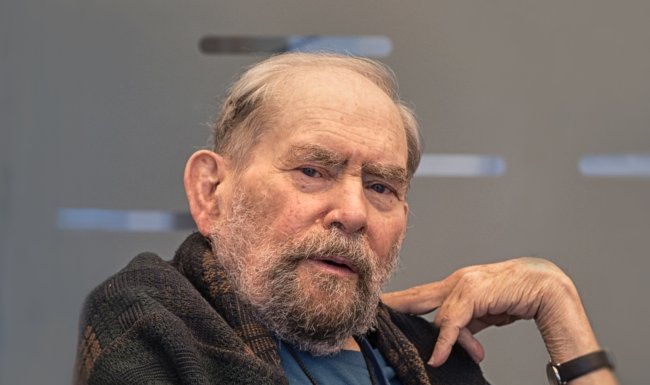
AsianScientist (Apr. 5, 2019) – Dr. Sydney Brenner, the visionary molecular biologist and Nobel laureate who turned a humble soil worm into one of the most-studied organisms in biology, died on April 5, 2019 in Singapore. He was 92.
In the 1960s, Brenner pioneered the use of Caenorhabditis elegans, a one-millimetre-long nematode worm with a translucent body and simple nervous system, as a model for understanding human biology. Since then, scores of researchers have used C. elegans to pick apart fundamental cellular processes such as cell division, embryo development, aging and cell death.
Few scientists make their mark on even one specialized field of research, but Brenner’s scientific career was marked by its versatility. A contemporary of Francis Crick and James Watson (who together with other researchers deduced the double helix structure of DNA in 1953), Brenner was instrumental in deciphering the basic principles of the genetic code—the instructions by which DNA codes for proteins.
As biologists went from studying individual genes to scanning entire genomes, Brenner would go on to invent new methods for reading DNA on a large scale. These later became the basis for the high-throughput DNA sequencing now routine in many laboratories.
Medicine’s loss, science’s gain
Brenner was born on January 13, 1927 in Germiston, South Africa, to Jewish immigrants from Eastern Europe. In 1942, after an accelerated grade school career, he enrolled in the University of the Witwatersrand in Johannesburg to study for a medical degree.
By his own admission a poor student of medicine, Brenner was instead captivated by courses in the natural sciences. A gap year, taken because he was deemed too young to qualify to practice medicine, solidified his passion for scientific research—Brenner spent it working in a laboratory, learning physical chemistry, neurology, microscopy, anthropology and paleontology from senior researchers. (“This was heaven,” he later wrote in his Nobel autobiography.)
After scraping through medical school, Brenner won a highly competitive scholarship to pursue his PhD at Oxford University in the UK. He moved there in 1952 to work in the laboratory of physical chemist Cyril Hinshelwood, who suggested that he study how bacteria develop resistance to bacteriophage (viruses that infect bacteria).
Decoding DNA
In 1953, Crick and Watson proposed the DNA double helix, a structure formed by paired chains of the nucleotide bases A, C, G and T. This milestone marked the start of the ‘golden age’ of molecular biology—over the next decade and a half, researchers would painstakingly work out the rules of the genetic code, the very basis of life.
That year, Brenner drove to Cambridge to see Crick and Watson’s model of DNA, an occasion he described as a watershed moment in his scientific career. “The moment I saw the model and heard about the complementing base pairs, I realized that it was the key to understanding all the problems in biology we had found intractable—it was the birth of molecular biology,” he wrote.
Still, the question of how just four bases could encode enough information to make all the proteins necessary for life remained unsolved. In 1956, Brenner joined Crick at the UK Medical Research Council’s laboratory in Cambridge—where they would share an office for the next 20 years—to work on cracking this puzzle.
In 1961, Brenner, Crick and others used a bacteriophage system to show that the genetic code is composed of non-overlapping triplets. Three bases, or a codon, are required to encode one amino acid, the basic building block of proteins. Turning next to the question of how information contained in DNA is communicated to the cell, Brenner collaborated with Matthew Meselson and Francois Jacob to demonstrate the existence of messenger RNA, an intermediate molecule that carries genetic messages from DNA in the nucleus to ribosomes—the cell’s protein-making machinery—in the cytoplasm of the cell.
A can of worms
By the mid-1960s, Brenner and Crick believed that the central problems of molecular biology had been solved; the details could be left to the many young scientists who were now entering the field. It was time to look for new and bigger problems.
Brenner, who was interested in the genetics of how complex organisms develop and nervous systems are wired, began to hunt for the right experimental organism to answer these questions. C. elegans fit the bill: the worm could be grown by the hundreds on petri dishes in the laboratory; its diminutive size meant that it would fit within the field of view of an electron microscope; and its translucent body made it easy for scientists to follow and observe biological processes. In a 1974 paper, Brenner laid out key aspects of C. elegans genetics, along with methods for studying it in the laboratory.
By tracking the lineages of every one of C. elegans’ 959 cells, scientists were able to link specific genes to key processes such as cell differentiation and organ development. The humble worm—more complex and hence more informative than bacteria and yeast, and yet easier to study than flies and zebrafish—turned out to be a powerful experimental system that today continues to be used by laboratories all over the world.
In 2002, Brenner shared the Nobel Prize in Physiology or Medicine with H. Robert Horvitz and John E. Sulston for their work in C. elegans on the genetics of programmed cell death. A finely controlled process required for normal tissue and organ development, programmed cell death can also play a role in diseases such as neurodegenerative conditions and certain cancers. The researchers identified genes that control programmed cell death in worms, laying the ground for studying its regulation in humans.
From genes to genomes
Brenner’s scientific contributions continued well into the genomic era. In the mid-1980s, he became a strong supporter of efforts to sequence the human genome, but believed the project was not yet feasible given the sequencing technology of the day. Further, he also believed that most of the human genome—some 97 percent of its three billion bases—was junk DNA, meaning that it didn’t code for anything; it did, however, make life difficult for scientists who were sifting through it for genes.
“My view at the time was that we should treat the human genome like income tax and find every legitimate way of avoiding sequencing it,” Brenner, who was also known for his dry wit, said in his Nobel lecture.
If not the human genome, then what? Brenner started a project to sequence the genome of the Takifugu rubripes puffer fish, known in Japan as fugu. Humans and fugu share the same basic vertebrate body plan and similar repertoires of genes, but the fish’s genome, for reasons yet unknown, contains almost no junk DNA. Like C. elegans, the compact fugu genome—published in 2002—was an ideal model for studying larger and more complex organisms like humans. Plus, it was cheaper, too—Brenner dubbed it the “discount genome,” as it offered researchers a 90 percent discount on the cost of sequencing.
At the same time, Brenner also wanted to improve on existing DNA sequencing techniques, recognizing that the ability to read genomes on a large scale would be needed to move the field forward. Together with Applied Biosystems founder Sam Eletr, he developed a technique for sequencing large numbers of DNA molecules in parallel by anchoring them to microscopic beads. Lynx Technologies, the company focused on commercializing this invention, was later acquired by Illumina, and the technology now forms the basis of what today is known as next-generation sequencing.
The Singapore connection
Brenner worked on the fugu genome from his laboratories at the University of Cambridge and at the Institute of Molecular and Cell Biology (IMCB) in Singapore. Brenner had been advising the Singapore government on scientific policy since the early 1980s; at the time, the country’s leaders were eager to diversify its economy from low-cost manufacturing into more highly skilled industries such as biotechnology.
On a visit to Singapore in 1984, Brenner met then prime minister Lee Kuan Yew, and proposed setting up a molecular biology research institute to train Singaporean PhDs. When Lee remarked that Singapore was a nation of technicians and not of scientists, Brenner replied with trademark candor: “Prime Minister, if you don’t do something like this, you will remain a nation of technicians.”
Singapore took his advice. The IMCB, set up in 1987, was followed by a host of other biomedical research institutes managed by the Agency for Science, Technology and Research, all located in a hub called the Biopolis—a name coined by Brenner. In 2003, he was made an honorary citizen in recognition of his contributions towards putting Singapore on the biomedical research world map.
One Biopolis research center in particular bears Brenner’s mark. In 2009, he established the Molecular Engineering Laboratory (MEL), which according to him was one of the first in the world to institutionalize molecular engineering, an interdisciplinary field focusing on the design and manipulation of molecules for myriad applications.
Brenner hoped MEL would serve as a training ground for Singapore’s next generation of talent. There, scientists, even the junior ones, were expected to be independent; in return, they got to work on problems that really interested them. “Ninety percent, maybe even more, of what goes on in research and development is essentially routine,” said Brenner. “And that’s fine. But you also need the talent to do something new.”
A chronicle for the future
Brenner remained a magnetic presence in Singapore’s scientific research scene up until his death. In 2016, he co-founded the Evolution Club, aimed at stimulating discussion in that field among scientists, scholars and the public. He envisioned ten seminars spanning ten billion years of evolution; these would follow a logarithmic time scale beginning 1010 years ago with the Big Bang, then moving to the origin of biological life 109 years ago, and so on, up to the development of modern human society in the present, or 10 years.
The result was the 2017 public lecture series ‘10-on-10: The Chronicles of Evolution.’ Experts on each evolutionary milestone—many of them friends or collaborators of Brenner’s—were invited to Singapore, where they gave talks to packed lecture halls.
Brenner himself, then 90, bookended the series. In the opening lecture, he dispelled the common misconception that biological evolution is a upward progression with a fixed purpose; at the series’ conclusion, he detailed his plans to construct genome maps of every organism that had been sequenced, in order to trace their evolutionary history.
“The big lesson to learn here is that in science, only mathematics is the art of the perfect. Physics is the art of the optimal, and biology is the art of the satisfactory: if it works, you keep it; if it doesn’t, you get rid of it,” he said. A book based on the lecture series has since been published.
Brenner, who was married to his wife May for 58 years until her death in 2010, is survived by their three children, Stefan, Belinda, Carla. His stepson, Jonathan, passed away in 2018.
———
Copyright: Asian Scientist Magazine; Photo: Bryan van der Beek/Asian Scientist Magazine.
Disclaimer: This article does not necessarily reflect the views of AsianScientist or its staff.












